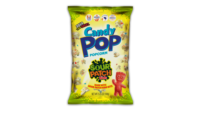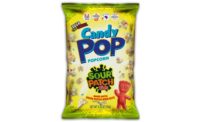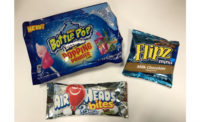Kids’ Candy Brands
Wooing today’s youthful confectionery consumers is more challenging than ever before but — considering their significant spending power — potentially more rewarding as well.
Kids’ Candy Brands*
Estimated U.S. Retail Market Size
$500 million
* Includes only non-chocolate kids’ candy
Source: Confectioner estimate based on input from
industry players
Overview
There are more than 40 million kids between the ages
of six and 14 in the United States, so the market opportunity is not to be
underestimated. In non-chocolate candy, kids’ brands represent 18
percent of sales for the 52-week period ending Dec. 3, 2005, according to
ACNielsen data.
Going after this market is no simple matter, however,
because — to badly paraphrase F. Scott Fitzgerald — “kids
are different than you and I” (assuming here that “you and
I” refers to adults). As experts on child development will tell you,
there’s a biological reality that explains why a child — and/or
teenager — doesn’t always seem to be thinking or acting
rationally.
During childhood, a child’s brain is still
forming the connection between the front lobe (home to faculties such as
reason and logic) and the back part of the brain, where the emotions
reside. Even teenagers do not have their logical capabilities fully
developed. (Which may not come as a great surprise to parents and teachers
everywhere!) Obviously then, when a brand that is to be targeted to kids is
being developed, it’s critical to figure out how to get inside the
heads — and hearts — of this sometimes-hard-to-figure and
always challenging target audience.
Those involved in formulating products for the youth
market point out that kids tend to go for different flavors than adults
might choose. For example, they frequently favor stronger, more intense
flavors, as well as sour flavors. Products that can be adapted to a
child’s own taste preferences — i.e. by blending flavors or
mixing up components — tap into an important aspect of
contemporary kids’ psyches — the desire for customization/i.e.
having it their way.
Demographics
It’s a mistake to apply a one-size-fits-all
approach to children. A child’s view of the world changes as he or
she ages. While a five- to seven-year-old may be intrigued by the
“magic” of a candy item, a nine- to 11-year-old will be more
interested in the “science” of it. So in the later case, a
savvy marketer might attempt to satisfy that child’s desire for
information by directing him or her to a Web site where it’s possible
to get additional information about the brand.
One leading marketer of branded kids’ candy
breaks out the target market like this: ages six to eight, nine to 11, and
12 to 14. Also, when marketing to kids, it’s important to remember
that children tend to have an “aspirational age” slightly older
than their chronological age, so it’s critical to position products
and to fashion advertising taking that into consideration.
Kids are a factor in the marketplace well before
they reach school-age. According to kids’ marketing guru James
McNeal, children make their first in-store requests at around age two, and
are beginning to do their own purchasing by the age of four or five.
Brands
Kids and brands? Oh, yes! Kids’ candy is an
impulse purchase to a great extent, and a strong brand helps a product to
stand out from the crowd. Queried about the importance of brand names to
kids, one marketer replied in this way: “If you don’t think
brands are important to kids, ask them what jeans they are wearing.”
According to one research study, babies as young as
six months of age are capable of forming mental images of corporate logos
and mascots. Brand loyalties can be established as early as age two. By the
time children are ready to start school, most can recognizes hundreds of
brand logos. Of course, much like adults,
youthful consumers will remain brand loyal only so long as that brand
continues to deliver what they like.
Marketing
Marketers of kids’ candy products must walk a
fine line. Cool and hip is good. So is a bit of attitude. But using
yesterday’s slang is not cool, so, if in doubt, skip it.
There are hundreds of magazines and newspapers
targeted to kids — or with sections targeting them — which can
be effective marketing vehicles in addition to advertising on kid-focused
television networks such as Nickelodeon.
By the middle school years, few things are as
important to kids as their peers’ opinions. Thus buzz marketing
— in which marketers sell some of the coolest kids on a product
concept and let them spread the word — can be a great tool for
reaching out to the youth market. And the Internet — blogs, news
groups, chat rooms and so on — can work well too.
Adjacencies
Candy products targeted to older kids tend to do well
when positioned near other items they’ll choose to spend their
discretionary income on — comic books, soda, magazines and the like.
Keeping products targeted to young kids lower on the plan-o-gram is
important as well.
Outlook
The purchasing power of children tripled in the 1990s,
according to “The U.S. Kids Market,” a research report from
Packaged Facts. Also according to that report, kids’ direct buying
power is expected to exceed $51.8 billion this year.
Not only does the youth market represent a huge market
opportunity for the candy category today, but its importance to your brand
in the decades ahead should not be underestimated. In just a decade or two,
today’s kids will be controlling the purse strings in households of
their own. Now is the time to develop brand awareness and allegiances that
will prove critical for generations to come.
Merchandising Musts
Cross it! Cross-promotion is a natural for the
kids’ candy category, and popular cartoons and movie/DVD releases
deliver a made-in-heaven opportunity for tie-ins.
Pay plenty of attention to visual presentation.
Kids today are watching television shows about how to redecorate their
rooms, so design and fresh presentation tend to be important to them.
Kids’ Market Close-Up
When targeting kids, keep in mind that this is a
racially and ethnically diverse group. Nearly 30 percent of six- to
11-year-olds are Hispanic, for example, compared with 12.4 percent of those
18 and older. And 15.4 percent of the kids in this age range are
African-Americans vs. 12 percent of adults. Thus members of this group, the
so-called “Matrix Generation,” enjoy a wide range of activities
and entertainment choices.
Kids in this demographic subset are expected to
continue the individualistic tendencies exhibited by all post-World War II
generations. Technologically savvy, they will also be just as well-educated
as their Generation X and baby boomer predecessor generations.



